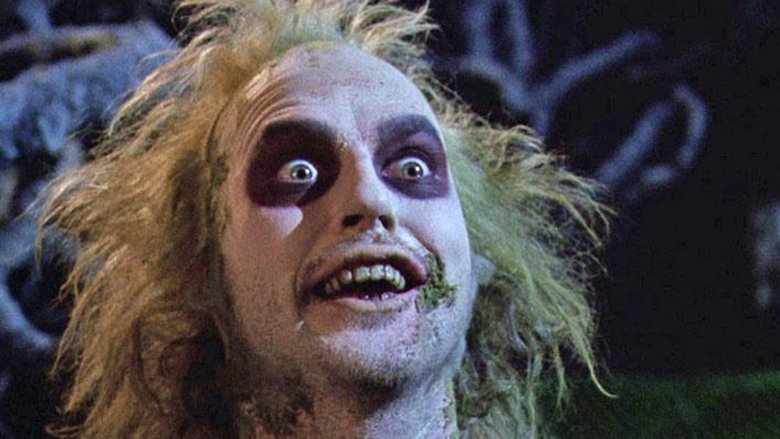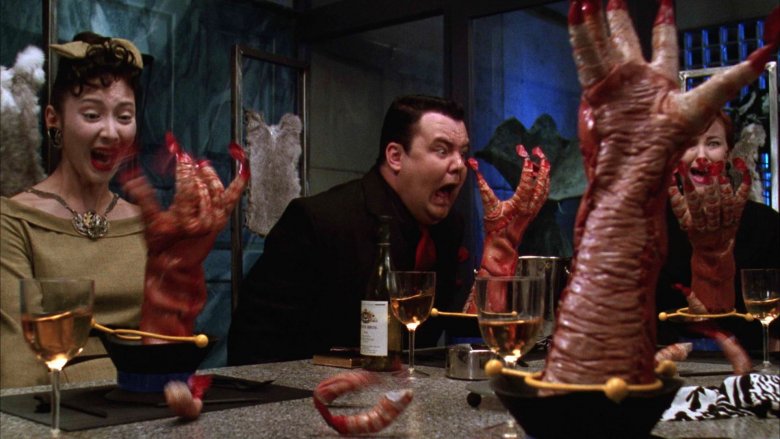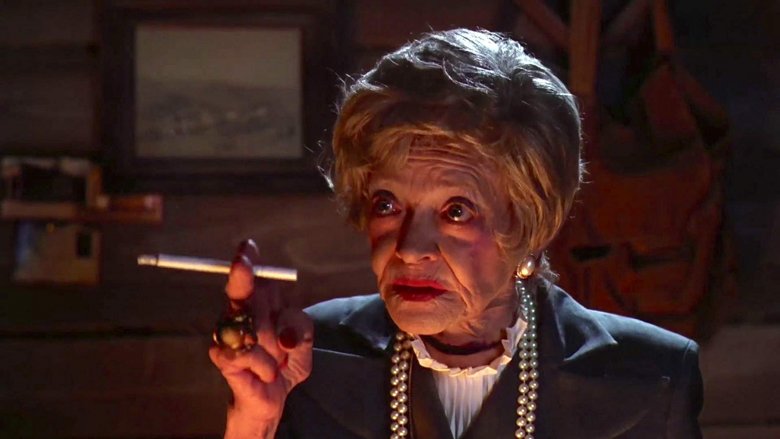Things Only Adults Notice In Beetlejuice
"Beetlejuice! Beetlejuice! Beetlejuice!" So goes the spell that releases the self-styled "bio-exorcist" Betelgeuse (more recognizably spelled "Beetlejuice," and played by Michael Keaton) to solve the human infestation plaguing recently deceased couple Adam (Alec Baldwin) and Barbara (Geena Davis) Maitland. The premise of Beetlejuice is so very out there, so weird and unexpected, that it continues to fascinate audiences to this day.
It was such a unique concept that it went on to spawn a much-beloved animated series that toned down some of the titular character's nastier habits and gave him and Lydia Deetz (Winona Ryder in the film) a fun, creepy romp of a friendship — far removed from the predatory antagonism portrayed in the film. But while kiddies everywhere enjoyed their weirdo cartoon shenanigans, adults were observing far different aspects of the original film — a film which, in many ways, was never catering to young audiences at the outset, but which wiggled its way into their awareness like a pesky sandworm. If you loved Beetlejuice as a kid and haven't revisited it in a while, here are some things that might surprise you. It's showtime.
The music
To young viewers who hadn't been exposed to much horror (comedic or otherwise), hearing the Caribbean musical stylings of singer-songwriter Harry Belafonte might not have seemed so out of place. And surely, Belafonte has utilized Caribbean folklore of a macabre nature in songs like "Zombie Jamboree," but that's not what made it into the Beetlejuice soundtrack. Instead, when the Deetzes are being haunted by their home's ghostly inhabitants, the bright, loud "Day-O!" from "The Banana Boat Song" rings out, a sharp contrast to the act of possession and supernatural harassment taking place.
In many ways, this contrast is very Burton-esque, as the director has frequently played with small-town everyday settings for his dark themed tales (such as in Edward Scissorhands a few years later). But in Warren Skaaren's first rewrite of Michael McDowell's original script, the intended genre was R&B instead of Calypso, with Lydia dancing to Percy Sledge's "When a Man Loves a Woman" at the end of the film instead of Belafonte's "Jump in the Line." No matter how you slice it, the musical decisions that might not make a kid blink twice seem outright odd to a lot of adults — and enhance the movie's strange appeal.
The gruesome deaths of the Neitherworld waiting room
When the Maitlands discover that they are ghosts and that newcomers have bought their home, they travel to the Land of the Dead (dubbed "The Neitherworld" in the animated series) in an attempt to get some help. Before they can see anyone about getting some help, they have to take a number and a seat in an afterlife waiting room. At the end of the movie, viewers see Beetlejuice in the same waiting room, stuck in a terminally long line. This scene plays on the joke of waiting rooms everywhere, which many young viewers might not have a lot of experience with. But that's not the most adult element of the sequence — it also showcases a parade of victims of various deaths that only a very twisted child would immediately grasp.
There is the jungle explorer with his shrunken head, shown later sitting near a witch doctor who presumably created the predicament to begin with. It's a silly gag, but in the modern age, when witch doctors are no longer part of the media landscape, it requires a certain understanding of old racially questionable tropes. At another juncture, the secretary lifts her wrists to display twin scars, implying she committed suicide. And there is a man who looks to be made completely of carbon who offers Adam a cigarette — a nod to the rising awareness of lung cancer, but also implying that this man probably died in a fire caused by falling asleep with a lit cigarette.
While these dead are intended to be amusing, it is perhaps for the best that the youngest viewers don't really understand how gruesome or horrible some of them are. Gallows humor is perhaps best saved for the cynical, or at least those who have a firmer grasp on mortality to begin with.
Rich socialites in Connecticut
Lydia's stepmother, Delia (Catherine O'Hara), is a high-class, high-maintenance sculptor from New York. Alongside her husband Charles Deetz (Jeffrey Jones), a former real estate developer, she seeks to transform the cozy Connecticut home they just purchased into a more modern, swanky, upscale abode. She brings in interior designer Otho (Glenn Shadix), and the two dig in to their new project — much to the chagrin of Adam and Barbara, who never got to grow old in the house they worked so hard to make their own.
Connecticut has long been notorious for having high-end, expensive property, especially second homes for the rich and/or famous. For example, rapper 50 Cent recently sold his Connecticut mansion for $2.9 million. Here, the film pokes fun at the self-styled eccentric wealthy folks from out of state who bluster into a sleepy town and drive up the property value for miles around, bringing the least desirable aspects of city life (like expensive everything) in their wake. This kind of dig requires a working knowledge of social politics and real estate anxieties in order to really appreciate it, something that most young viewers — probably even those in their teens — won't readily get.
(Re)building a family
A child viewer who is part of a stepfamily, or who has a friend with a stepparent, will be able to recognize some of Lydia's challenges in dealing with her overbearing new stepmother. But it takes an adult eye, particularly that of a parent, to recognize the roadblocks that both Lydia and Delia are struggling through as they learn to cohabitate. Lydia has lost her mother and feels that her father is trying to replace that memory. Delia, previously without parental responsibility, does not understand how to show affection or effectively provide discipline, support, or understanding to her new stepdaughter.
Because of these hang-ups, the two remain distant for the whole film, and Charles Deetz doesn't know how to bring the two most important ladies in his life together to form one family. This anxiety over trying to build a new family will be familiar to many adults, whether they were the child, parent, or stepparent in their own restructured home.
Everything that comes out of Beetlejuice's mouth
The character of Beetlejuice is a lot, in every sense of the word. He's loud, he's brash, he's completely over-the-top. And everything that he says, in his lickety-split used-car-salesman patter, requires some solid pop culture background — and a willingness to lean in to the dirty jokes. He claims that The Exorcist "keeps getting funnier" every time he sees it — and hopefully no young viewers have seen that movie, because it's decidedly not supposed to be funny in the least. He also shouts, "Go ahead, make my millennium!" in a clear reference to the Dirty Harry movie Sudden Impact, another film that young folks probably wouldn't have much interest in seeing.
And of course, Beetlejuice is a troublesome pervert, the kind of ghost you definitely don't want around your teenage daughter. This is played for laughs, but an adult viewer will find the "ghost with the most" to be truly gross in his treatment of Lydia, forcing her into a marriage and implying with great alacrity his intentions for their wedding night. Basically, Beetlejuice is the least kid-friendly part of Beetlejuice.
Beetlejuice is named after a star
Though the name "Beetlejuice" is perfectly creepy and gross for the titular character, his actual name, Betelgeuse, is the name of a star in the constellation Orion. There doesn't seem to be any specific reason for this other than it sounds cool, but some translations of the name, which comes from Arabic, indicate that it means "armpit of Orion." For a ghost who looks (and probably smells) like he came out of someone's armpit, this choice seems particularly apt.
Otherwise, the use of a star's name lends a kind of mystical, magical, witchy element to a character who is decidedly none of those things — though Lydia and her fascination with the dead might qualify as sufficiently witchy. This is one of those little factoids that adults with an eye for the skies might recognize before their younger counterparts — unless they have kids who are really into astronomy and who make a point of locating the brightest star in the constellation Orion!
The makeup and practical effects of Beetlejuice
When a special effect in film is well-done, hopefully the audience doesn't notice it. Certainly, kids who are already prone to suspending their disbelief are more susceptible to accepting strange visuals without question. And the visuals in Beetlejuice, along with everything else, certainly are strange. From the Maitlands' stretched-out scary faces, to closets teeming with sandworms, to shrimp cocktail attacking a dinner party, the effects crew on the film was kept busy, and did an incredible job of it.
Beetlejuice even won the Academy Award for Best Makeup in 1989, a tribute to not only Michael Keaton's unrecognizable visage, but also the incredible prosthetics on the Maitlands and various inhabitants of the Neitherworld. Any adult who can step back from the wacky action long enough can look at the film with a critical eye and recognize that a great deal of work went into making this movie stunning to observe.
Winona Ryder's breakthrough
Winona Ryder has come back in a big way with her role as Joyce Byers in Netflix's Stranger Things. To this end, young viewers take her presence on screen for granted — if they recognize her at all. Her young Stranger Things co-star Priah Ferguson admits that she didn't know who Ryder was before she met her on set. But older fans will know that Beetlejuice was Ryder's big break after roles in a couple lesser-known movies, which would lead her to a long and diverse screen career, working with director Tim Burton frequently.
Ryder was only 17 years old when she played Lydia Deetz (who was supposed to be even younger), proving that even lacking in age, she was already quite skilled. The year after Beetlejuice was released, she starred in Heathers, further cementing her status as a rising young star. Possessing the gift of hindsight, adult viewers of Beetlejuice today can see Ryder's acting trajectory in ways that younger audiences cannot appreciate.
Beetle-Batman
The role of Batman has been played by many actors (and many more have come close), and we're now preparing to see Twilight star Robert Pattinson take up the cowl. But one of the more surprising entrants into this exclusive Bat-club is Michael Keaton. Completely caked in undead makeup and spouting endless gross-out euphemisms, Keaton's Beetlejuice seems to have more in common with Gotham's Joker than its Dark Knight. But just one year after playing the wacky bio-exorcist, Keaton brooded his way through Tim Burton's Batman film, proving to be just as adept a dramatic superhero actor as a farcical ghost-clown.
Keaton has never allowed himself to be typecast, jumping from one role to the next, seemingly unrelated one without a backward glance. It's hard to say if young viewers would even recognize him as Vulture in Spider-Man: Homecoming, since he's so good at seamlessly throwing himself into a role — and since their parents are much more likely to remember him from his heyday in the '80s and '90s.
Sylvia Sidney's contribution
This tidbit really applies chiefly to adults watching Beetlejuice for the first time in 1988 who might recognize a storied Hollywood actress from back when the film industry was still relatively young. Sylvia Sidney started her film career in the late 1920s and continued working for the next 71 years, developing an impressive portfolio of roles. In Beetlejuice, she plays the Maitlands' caseworker Juno, who gives them some advice on how to deal with their new human infestation.
Juno is shown smoking a cigarette and then having the smoke exit through a slash in her throat. This could be read as a tracheotomy scar, but since so many civil servants in the Neitherworld seem to be those who have died by their own hand, it could also imply that she slit her own throat. Of course, as the awareness around the evils of smoking became more readily known and discussed in the late '80s and into the '90s, one could guess that choosing to smoke was in and of itself a slow suicide.
Regardless, a little over a decade later, Sidney would actually die of esophageal cancer, an event which was seemingly presaged by her role as Juno — a fact that surely did not escape movie-going grown-ups at the time. Sidney won the Saturn Award for Best Supporting Actress in Beetlejuice, her last award before her death. She would re-team with Burton once more, in 1996's Mars Attacks!










